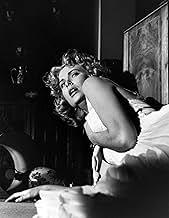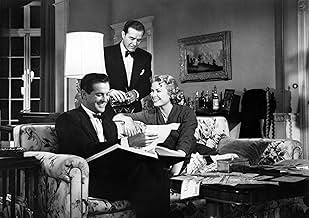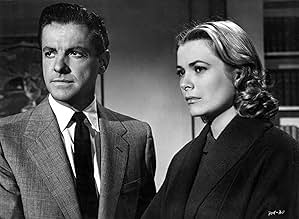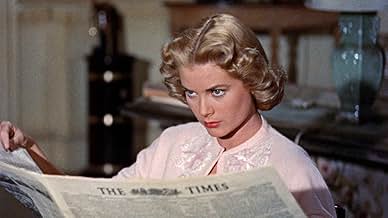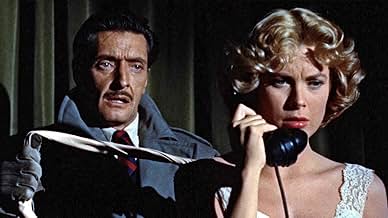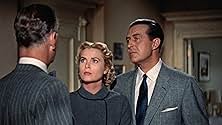Un ancien joueur de tennis décide de tuer sa femme pour hériter de son argent et se venger d'un cas qu'elle avait eu. Mais les choses ne se dérouleront pas comme prévu.Un ancien joueur de tennis décide de tuer sa femme pour hériter de son argent et se venger d'un cas qu'elle avait eu. Mais les choses ne se dérouleront pas comme prévu.Un ancien joueur de tennis décide de tuer sa femme pour hériter de son argent et se venger d'un cas qu'elle avait eu. Mais les choses ne se dérouleront pas comme prévu.
- Réalisation
- Scénario
- Casting principal
- Nomination aux 1 BAFTA Award
- 5 victoires et 3 nominations au total
- Banquet Member
- (non crédité)
- Detective
- (non crédité)
- Bobby Outside Flat
- (non crédité)
- Police Photographer
- (non crédité)
- Detective
- (non crédité)
- Woman Departing Ship
- (non crédité)
- Banquet Member
- (non crédité)
- Banquet Member
- (non crédité)
Résumé
Avis à la une
But the dialogue, put on film here, is exceptional. I write this review having seen "Dial M for Murder" two or three times and wanting to see it once again. Many reviewers, myself included, have tried watching films with the sound off. I want to try the opposite. I want to close my eyes and just listen to the dialogue because it's so strong. The MacGuffin conversation at the beginning, with a perfectly cast Ray Milland blackmailing a perfectly cast Anthony Dawson into murdering a perfectly cast Grace Kelly is brilliantly written by Mr. Knott. It was clearly from a stage production, as it explains the plot background in great detail, and goes on for the better part of twenty minutes. Both men are fleshed out, giving us their personalities and individual tendencies. And even though "Dial M for Murder" pretty much stays on just one small set (an apartment in London, in which we see mostly the foyer, a little of the bedroom, and just a glimpse of the kitchen), what happens there is so fascinating that we do not really want to venture out into the city.
And that is just the setup. The dialogue remains insistently interesting and clever throughout the picture. It also has that subtle, dark sense of humor that Alfred Hitchcock was keen on. It also has the ironic touches, such as when Mr. Milland, as the jealous husband, kisses his unfaithful wife on the night she is to be murdered, and tells her: "Goodbye, my dear." The audience, having been given every single little detail about the scheme and how it is to unfold, cringes with a dark realization that Mr. Hitchcock might just go through with Mr. Milland's plot. Mr. Hitchcock, as the director, is also due tremendous credit for his trademark of creating tension. Screenwriter Knott brilliantly lays out for the audience, not the victim, how the murder will go through, but Mr. Hitchcock's camera dutifully follows everything as the scheme goes along. And, before we realize it, if something starts to go wrong, we become scared and tense. And you can imagine my guilt when I realized I was feeling scared that a plan to murder someone just might not go through. It's Mr. Hitchcock's gift at work.
Dimitri Tiomkin, a very good film composer, hits all the write notes; that includes knowing when he needs to tell his violins and trumpets to shut up. Robert Burks' cinematography is also strong with effective usage of shadows and streaks of light. Colors are omnipresent. And even though "Dial M for Murder" was shot with the intent to be seen in 3D, it is hardly evident. When I first saw the film, in much superior 2D, I did not mind the lamps and such in the foreground, such as when one bisects the screen between Ray Milland and Anthony Dawson during the opening sequence. I just thought it was a clever piece of filmmaking and misc en scene, not a cheap gimmick like in most 3D movies today. "Dial M for Murder" is a near-perfect movie of its kind, pumped full of smart dialogue and dazzling energy. This is one of the few play-to-movie transition that I have seen where I have suddenly become eager to see the original stage production.
Time has not diminished this gem and it deserves its fame and status.
The movie is the story of Tony Wendice (Ray Milland), a former tennis player married to the beautiful and wealthy Margot (Grace Kelly) and living in an nice apartment in London. Life is good for Tony, until he discovers that his wife is cheating on him with an old flame of her, famous crime novel writer Mark Halliday (Robert Cummings). After that discovery, Tony spends a whole years plotting the perfect way to murder his wife in order to inherit her money, carefully planning every detail of the crime. When Mark visits London again, Tony finds the perfect chance to set his plan in motion, and as planned, he recruits Charles Swann (Anthony Dawson) to kill his wife. However, bad luck and a sudden change of events will test Tony's plan's infallibility as, just as Mark points out, human action can originate flaws even in the most perfectly devised plan.
Like most Hitchcock's films, "Dial M for Murder" was an adaptation of another art-form, this time a popular play by Frederick Knott. As Knott was also the writer of the screenplay, the movie remains extremely faithful to the play, although of course, not without its differences. Knott's script is wonderfully constructed, as like in the play, the dialog is witty and simply captivating, with many twists and turns that spiced up the complex plot and keep it from being boring or tiresome. An interesting feature of the movie is that oddly, there are no black and white morality in the characters, and it's easy not only to sympathize with Margot (despite she being cheating on her husband) but also to sympathize with Tony (despite he wanting to kill his wife), as the characters are wonderfully developed with very detailed personalities.
It seems that Hitchcock's knows that the dialog is the highlight of the play, as he deliberately focuses on his actors and uses an elegant camera-work to frame the whole movie inside the apartment. The movie literally is shot entirely in one single room (only two other sets are used, and only briefly), but Hitchcock's classy way of using the camera allow a highly dynamic flow that never lets the movie be tiresome. This is also very helpful as Hitchcock just lets his characters keep speaking, carefully describing actions and events (when other directors would use flashbacks) in a similar way to a what the real play would be. While this approach could easily get boring, Hitchcock's use of colors and overall visual imagery simply creates the perfect medium to allow Knott's dialog to shine.
Without disrespecting John Ford or Fred Zinnemann, I think that it was Hitchcock who finally could allow Kelly's talent to shine beyond her physical beauty. Grace Kelly makes her character shine with her subtle and restrained performance, specially showing her skill in the second half of the film. While often Kelly receives top honors in this movie, it is actually Ray Milland who makes the whole movie work with his suave and charming "villian". Milland's performance is simply terrific, making his character nice enough to win the sympathies of the audience, yet still frighteningly intelligent as the mastermind of the plot. John Williams appears as the Inspector in charge to solve the complex puzzle, and delivers a classic performance as the Enlgish gentleman decided to find the final answer. Only Robert Cummings seems miscast as Mark Halliday, although a lot of his weak performance could be blamed to Milland, Kelly and Williams overshadowing him with their excellent work.
In many ways, "Dial M for Murder" shares many things with "Rope", as not only the two films are based on successful plays, they are also about committing the perfect murder and oddly, they are both "experiments": while "Rope" was conceived as a "movie in one take", "Dial M for Murder" was done as 3-D movie. Sadly, the interest in 3-D was dying when the film was released, so few theaters carried the movie complete with the gimmick; a real shame, as Hitchcock's use of the technology, unlike most 3-D films of its time, was conceived as a way to enhance the claustrophobia of the Wendices' apartment instead of using it to merely shock the audience with "stuff coming out of the screen" (as seen in for example, "House of Wax"). While not too fond of the gimmick, Hitchcock truly gave it a good and intelligent (albeit subtle) use to it.
"Dial M for Murder" is probably less celebrated than the Master's most famous movies, the fact that it came out the same years as "Rear Window" (again with Grace Kelly) may have had something to do with it too. While a subtler and more restrained tale of suspense, this is still the Master at his best, as the movie proves that when he was at the top of his game, no other director was comparable to him. 9/10
However. it actually has a lot going for it, being beautifully shot in luminous colour, extremely well acted in almost every role and peppered throughout with those eye-catching and brain-satisfying flourishes which so distinguished the director from the rest.
Yes, it is very set-bound, betraying its stage origins and likewise very talky, especially on exposition, but it keeps the viewer alert throughout and delivers a neatly satisfying conclusion. I do wish Hitchcock could have done better with his back-projection unit (an old-fashioned, jarring trait he still hadn't grown out of by "Marnie" some 10 years later) and I occasionally found the constant too frivolous background music an intrusion, but it's well paced throughout, helped considerably by an on-form cast.
Ray Milland is excellent in a kind of darker Cary Grant type persona, Grace Kelly (who'd want to murder her?) goes convincingly from loveliness to wretchedness while it's pleasing to see Robert Cumming to the fore, recalled by Hitch for the first time in over a decade (since "Saboteur" in 1942). The actors playing the would be murderer and nosey police inspector are just fine too.
About those flourishes..., perhaps the most famous being the changing spotlight on Grace Kelly's doomed face as her trial is condensed into just a few terse minutes and of course the murder scene itself, even if one can't imagine her extended stabbing gesture being strong enough to cut through Swann's jacket far less kill him stone dead, but I also enjoyed the raised tracking shot looking down on Milland as he explains his plot to Swann and particularly the parting shadows of lovers Cumming and Kelly at Milland's unexpected approach.
Yes, it's old fashioned Hollywood movie-making, but it's old-fashioned Hollywood movie-making at its best and in my opinion an unjustly overlooked effort from the Master.
Le saviez-vous
- AnecdotesAlfred Hitchcock wanted Cary Grant to star, but Warner Brothers felt that he would be miscast as a villain.
- GaffesWendice throws a £100 bundle on a pink armchair. The money falls right at the back of the seat. A few minutes later, Swann takes the money which is now right in front of the armchair.
- Citations
Tony Wendice: How do you go about writing a detective story?
Mark Halliday: Well, you forget detection and concentrate on crime. Crime's the thing. And then you imagine you're going to steal something or murder somebody.
Tony Wendice: Oh, is that how you do it? It's interesting.
Mark Halliday: Yes, I usually put myself in the criminal's shoes and then I keep asking myself, uh, what do I do next?
Margot Mary Wendice: Do you really believe in the perfect murder?
Mark Halliday: Mmm, yes, absolutely. On paper, that is. And I think I could, uh, plan one better than most people; but I doubt if I could carry it out.
Tony Wendice: Oh? Why not?
Mark Halliday: Well, because in stories things usually turn out the way the author wants them to; and in real life they don't... always.
Tony Wendice: Hmm.
Mark Halliday: No, I'm afraid my murders would be something like my bridge: I'd make some stupid mistake and never realize it until I found everybody was looking at me.
- Crédits fousThe title is shown on a background of a British telephone dial; its MNO marking is replaced by a single large M which forms the single M of the title.
- Versions alternativesThe film had an intermission in its original 3-D release, although it is less than two hours in length.
- ConnexionsEdited into Histoire(s) du cinéma: Le contrôle de l'univers (1999)
Meilleurs choix
Détails
- Date de sortie
- Pays d’origine
- Langue
- Aussi connu sous le nom de
- Con M de Muerte
- Lieux de tournage
- Société de production
- Voir plus de crédits d'entreprise sur IMDbPro
Box-office
- Budget
- 1 400 000 $US (estimé)
- Montant brut aux États-Unis et au Canada
- 24 845 $US
- Week-end de sortie aux États-Unis et au Canada
- 12 562 $US
- 11 avr. 1999
- Montant brut mondial
- 45 313 $US
- Durée1 heure 45 minutes
- Couleur
- Rapport de forme
- 1.66 : 1
Contribuer à cette page




